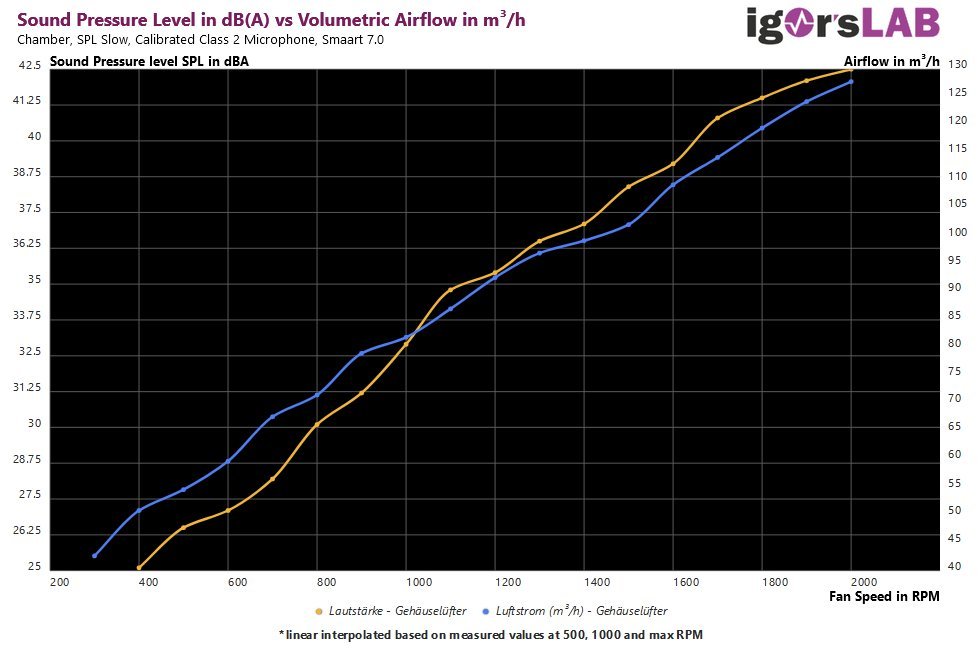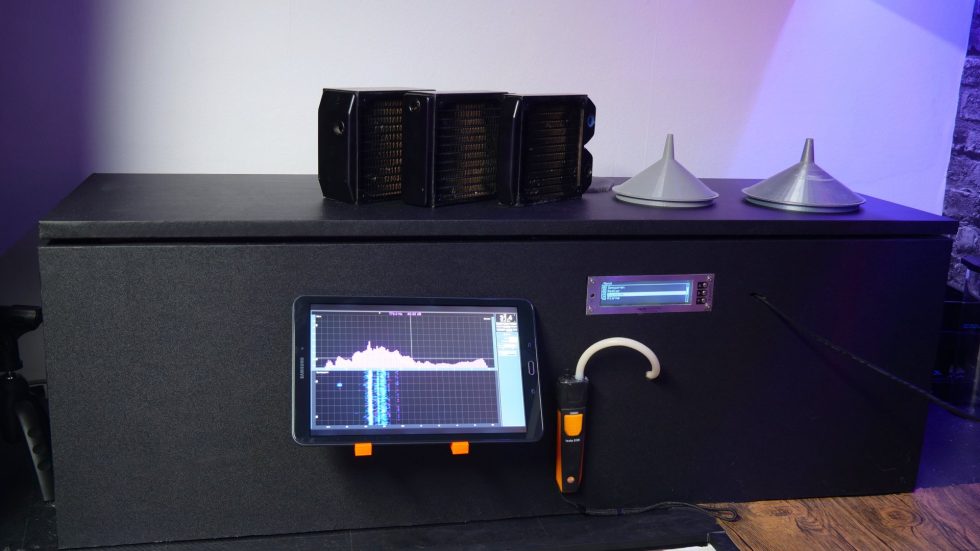Today we start the beta phase of our first interactive fan database and offer for the first time a variety of real measurement results compared to the manufacturer data in an interactive database, which allows comparisons of application scenarios and speeds that did not exist so far. Since there is currently no source that offers realistic and usable data, even in direct comparison, we have invested a lot of time and money and, with the advice of a large German cooling and air conditioning manufacturer, simply developed our own fan measuring station and then calibrated it on site in the laboratory. Our colleague Pascal Mouchel did a great job and the result is quite impressive. The heavy and massive body with two chambers made of thick MDF boards was calculated in cooperation with the manufacturer’s engineering, planned in the implementation and of course also soundproofed.
Of course, what we can measure from now on doesn’t meet any ISO standard, but the differences to the million-dollar original chamber of the supporting manufacturer are in a range where the manufacturing tolerances of the fans already start. Thus, the ideal can be approached quite well, especially since the installed measuring devices were individually selected from a larger quantity and then also professionally calibrated at great expense. This makes such an investment, including hardware and software, almost worth five figures, but you don’t have to spend six figures to be able to objectively evaluate a fan in the end. That’s because we measure a total of 4 installation scenarios in 100-RPM steps, then create a high-quality long-term audio recording over the entire speed band in each case and offer a frequency analysis. In addition, we provide all DC and PWM controlled results up to the respective power consumption.
Since there is a lot of know-how, time and also money involved in the setup, we will only describe here the things that are really necessary to understand the tests. This is not a blueprint for rebuilding. A very simplified version with a long tube instead of the chamber would have been much cheaper, but it is so inaccurate due to the design that the values can only be considered as a rough estimate with many errors. The pressure drop is immense and a serious sound level measurement is simply impossible due to the resonant body thus created. Values below approx. 30 CFM can hardly be evaluated in a meaningful way. There were also such tubes as a promo action of different fan manufacturers to measure, but more than nice toys are these all not.
Planned updates and new fans
- After we released the beta on Thursday, I received a lot of feedback from the community. This was reason enough for our programmer to go one step further and implement what makes sense from a technical point of view. Thus, two new columns can already be used for ranking: Airflow per dBA and static pressure per dBA. Since this ratio is rather confusing, we have normalized the results in relation to the best fan in this category, which then represents the 100% mark. All other fans are subordinated in percentage.
- Additionally, we have implemented five interactive charts below the ranking table with 10 entries per page.
- We also expect an influx of other current fans in the next few days, which we will then promptly include.
In the beta phase, there is still the restriction with the subsequently interpolated and partly not yet collected data (100 rpm steps) of the older, first fan tests, which we will complete step by step over time. If no data is visible in some metrics or lists, this is not an error of the software, but is subject to the conditions of the respective acquisition period. All newer fans have already been completely integrated. We apologize for any display errors in the software or in the data entry and we will then also adjust the whole thing in a timely manner. Please send your comments and suggestions exclusively by e-mail to [email protected].
Either you click on one of the above links to start the database or on the respective headline of the description.
Fan search and overview (ranking)
Here you can find all fans tested so far and you can search for many features individually or in combination. The tables can also be sorted by features in ascending or descending order. For each individual fan there is of course also a detailed view with all recorded and measured data, up to sound examples and exact frequency analyses.
Direct 1:1 comparison of two fans
You can compare two fans in detail on this page. In the selection lists you will find all fans listed in alphabetical order. Thus, the comparison can be individualized as desired. For each individual fan there is of course also a detailed view with all recorded and measured data, up to individual reviews, sound examples and exact frequency analyses.
Test methods and equipment
For the methodology and equipment you will find here and in the menus the corresponding button to an extra page, which explains everything really detailed.
Details for each single fan (Example)
Both the listings and the 1:1 comparison offer the opportunity to display all the data stored for each individual fan. This ranges from manufacturer information, the image gallery, links to individual reviews, to all available measurement data, audio samples, and the price search engine. The special feature lies in the freely selectable display options, where one can individually combine different data such as throughput vs. volume. A mouse-over over the points of the curves in the graphics also allows the exact reading of the measurement values using a tooltip.
Pascal made a short tutorial how to use this database. It’s in German but understandable. We also will make a lot auf changes and improvements in the next days, so stay tuned:
Example for a single fan (Example)


































209 Antworten
Kommentar
Lade neue Kommentare
Urgestein
Urgestein
Urgestein
1
1
Veteran
Administrator
1
1
Urgestein
Urgestein
1
Veteran
Urgestein
Mitglied
Veteran
Urgestein
Urgestein
Urgestein
Alle Kommentare lesen unter igor´sLAB Community →